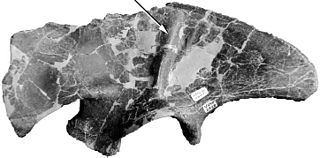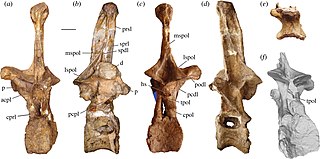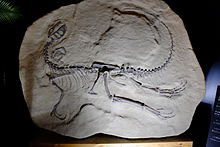
Allosaurus is an extinct genus of large carnosaurian theropod dinosaur that lived 155 to 145 million years ago during the Late Jurassic period. The name "Allosaurus" means "different lizard", alluding to its unique concave vertebrae. It is derived from the Greek words ἄλλος and σαῦρος. The first fossil remains that could definitively be ascribed to this genus were described in 1877 by famed paleontologist Othniel Charles Marsh. As one of the first well-known theropod dinosaurs, it has long attracted attention outside of paleontological circles.

Ceratosaurus was a carnivorous theropod dinosaur that lived in the Late Jurassic period. The genus was first described in 1884 by American paleontologist Othniel Charles Marsh based on a nearly complete skeleton discovered in Garden Park, Colorado, in rocks belonging to the Morrison Formation. The type species is Ceratosaurus nasicornis.

Torvosaurus is a genus of large megalosaurine theropod dinosaur that lived approximately 165 to 148 million years ago during the Callovian to Tithonian ages of the late Middle and Late Jurassic period in what is now Colorado, Portugal, Germany, and possibly England, Spain, Tanzania, and Uruguay. It contains two currently recognized species, Torvosaurus tanneri and Torvosaurus gurneyi, plus a third unnamed species from Germany.

Dryosaurus is a genus of an ornithopod dinosaur that lived in the Late Jurassic period. It was an iguanodont. Fossils have been found in the western United States and were first discovered in the late 19th century. Valdosaurus canaliculatus and Dysalotosaurus lettowvorbecki were both formerly considered to represent species of Dryosaurus.

Ornitholestes is a small theropod dinosaur of the late Jurassic of Western Laurasia.
Coelurus is a genus of coelurosaurian dinosaur from the Late Jurassic period. The name means "hollow tail", referring to its hollow tail vertebrae. Although its name is linked to one of the main divisions of theropods (Coelurosauria), it has historically been poorly understood, and sometimes confused with its better-known contemporary Ornitholestes. Like many dinosaurs studied in the early years of paleontology, it has had a confusing taxonomic history, with several species being named and later transferred to other genera or abandoned. Only one species is currently recognized as valid: the type species, C. fragilis, described by Othniel Charles Marsh in 1879. It is known from one partial skeleton found in the Morrison Formation of Wyoming, United States. It was a small bipedal carnivore with elongate legs.

Proceratosaurus is a genus of carnivorous theropod dinosaur from the Middle Jurassic (Bathonian) of England. It contains a single species. P. bradleyi, known from a mostly complete skull and lower jaws. Proceratosaurus was a small dinosaur, estimated to measure around 3 m (9.8 ft) in length. Its name refers to how it was originally thought to be an ancestor of Ceratosaurus, due to the partially preserved portion of the crest of Proceratosaurus superficially resembling the small crest of Ceratosaurus. Now, however, it is considered a coelurosaur, specifically a member of the family Proceratosauridae, and amongst the earliest known members of the clade Tyrannosauroidea.

Elaphrosaurus is a genus of ceratosaurian theropod dinosaur that lived approximately 154 to 150 million years ago during the Late Jurassic Period in what is now Tanzania in Africa. Elaphrosaurus was a medium-sized but lightly built member of the group that could grow up to 6.2 m (20 ft) long. Morphologically, this dinosaur is significant in two ways. Firstly, it has a relatively long body but is very shallow-chested for a theropod of its size. Secondly, it has very short hindlimbs in comparison with its body. Phylogenetic analyses indicate that this genus is likely a ceratosaur. Earlier suggestions that it is a late surviving coelophysoid have been examined but generally dismissed. Elaphrosaurus is currently believed to be a very close relative of Limusaurus, an unusual beaked ceratosaurian which may have been either herbivorous or omnivorous.

Saurophaganax is a genus of large allosaurid dinosaur from the Morrison Formation of Late Jurassic Oklahoma, United States. Some paleontologists consider it to be a junior synonym and species of Allosaurus. Saurophaganax represents a very large Morrison allosaurid characterized by horizontal laminae at the bases of the dorsal neural spines above the transverse processes, and "meat-chopper" chevrons. It was the largest terrestrial carnivore of North America during the Late Jurassic, reaching 10.5 metres (34 ft) in length and 2.7–3.8 metric tons in body mass.

Gargoyleosaurus is one of the earliest ankylosaurs known from reasonably complete fossil remains. The holotype was discovered in 1995 at the Bone Cabin Quarry West locality, in Albany County, Wyoming in exposures of the Upper Jurassic Morrison Formation.

Stokesosaurus is a genus of small, carnivorous early tyrannosauroid theropod dinosaurs from the late Jurassic period of Utah, United States.

Xinjiangovenator is a genus of coelurosaurian dinosaurs, possibly part of the group Maniraptora, which lived during the Early Cretaceous period, sometime between the Valanginian and Albian stages. The remains of Xinjiangovenator were found in the Lianmuqin Formation of Wuerho, Xinjiang, China, and were first described by Dong Zhiming in 1973. The genus is based on a single specimen, an articulated partial right lower leg, containing the tibia, three pieces of the fibula, the calcaneum and the astragalus. This specimen, IVPP V4024-2, is the holotype of the genus.

Marshosaurus is a genus of medium-sized carnivorous theropod dinosaur, belonging to the Megalosauroidea, from the Late Jurassic Morrison Formation of Utah and possibly Colorado.

Amphicoelias is a genus of herbivorous sauropod dinosaur that lived approximately 150 million years ago during the Tithonian of what is now Colorado, United States. Amphicoelias was moderately sized at about 18 metres (59 ft) in length and 15 metric tons in body mass, shorter than its close relative Diplodocus. Its hindlimbs were very long and thin, and its forelimbs were proportionally longer than in relatives.

Peloroplites is a monospecific genus of nodosaurid dinosaur from Utah that lived during the Late Cretaceous in what is now the Mussentuchit Member of the Cedar Mountain Formation. The type and only species, Peloroplites cedrimontanus, is known from a partial skull and postcranial skeleton. It was named in 2008 by Kenneth Carpenter and colleagues. Peloroplites was 6 metres long and weighed 2 tonnes, making it one of the largest known nodosaurids, and came from a time when ankylosaurids and nodosaurids were attaining large sizes.

Zuolong is an extinct genus of tetanuran theropod from the Late Jurassic period of China. The type and only species is Z. salleei. The generic name of Zuolong is in honor of General Zu Zōngtáng with the Chinese word "long" which means dragon. The specific epithet "salleei" is in honor of Hilmar Sallee, who funded the expedition which led to the specimen's discovery.

Uteodon is a genus of herbivorous iguanodontian dinosaur. It is a basal iguanodontian which lived during the late Jurassic period in what is now Uintah County, Utah. It is known from the middle of the Brushy Basin Member, Morrison Formation. The genus was named by Andrew T. McDonald in 2011 and the type species is U. aphanoecetes.

Daemonosaurus is an extinct genus of possible theropod dinosaur from the Late Triassic of New Mexico. The only known fossil is a skull and neck fragments from deposits of the latest Triassic Chinle Formation at Ghost Ranch. Daemonosaurus was an unusual dinosaur with a short skull and large, fang-like teeth. It lived alongside early neotheropods such as Coelophysis, which would have been among the most common dinosaurs by the end of the Triassic. However, Daemonosaurus retains several plesiomorphic ("primitive") traits of the snout, and it likely lies outside the clade Neotheropoda. It may be considered a late-surviving basal theropod or non-theropod basal saurischian, possibly allied to other early predatory dinosaurs such as herrerasaurids or Tawa.
Panguraptor is a genus of coelophysid theropod dinosaur known from fossils discovered in Lower Jurassic rocks of southern China. The type and only known species is Panguraptor lufengensis. The generic name refers to the deity Pangu but also to the supercontinent Pangaea for which in a geological context the same characters are used: 盘古. Raptor means "seizer", "robber" in Latin. The specific name is a reference to the Lufeng Formation. The holotype specimen was recovered on 12 October 2007 from the Lufeng Formation of Yunnan, which is noted for sauropodomorph fossils. It was described in 2014 by You Hai-Lu and colleagues.




































